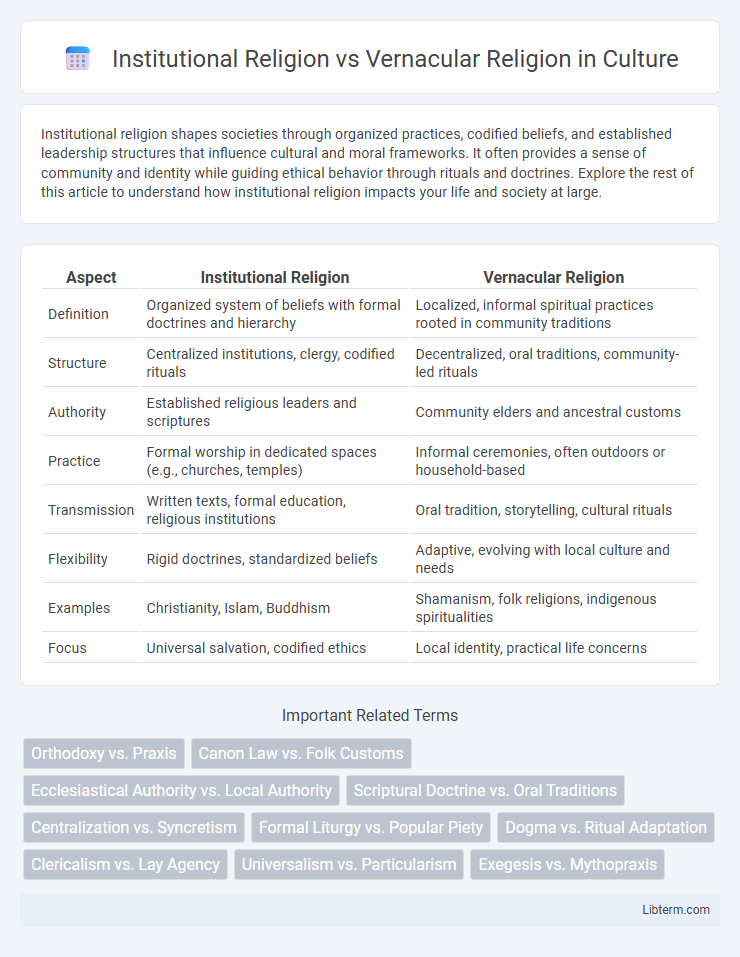Institutional religion shapes societies through organized practices, codified beliefs, and established leadership structures that influence cultural and moral frameworks. It often provides a sense of community and identity while guiding ethical behavior through rituals and doctrines. Explore the rest of this article to understand how institutional religion impacts your life and society at large.
Table of Comparison
| Aspect | Institutional Religion | Vernacular Religion |
|---|---|---|
| Definition | Organized system of beliefs with formal doctrines and hierarchy | Localized, informal spiritual practices rooted in community traditions |
| Structure | Centralized institutions, clergy, codified rituals | Decentralized, oral traditions, community-led rituals |
| Authority | Established religious leaders and scriptures | Community elders and ancestral customs |
| Practice | Formal worship in dedicated spaces (e.g., churches, temples) | Informal ceremonies, often outdoors or household-based |
| Transmission | Written texts, formal education, religious institutions | Oral tradition, storytelling, cultural rituals |
| Flexibility | Rigid doctrines, standardized beliefs | Adaptive, evolving with local culture and needs |
| Examples | Christianity, Islam, Buddhism | Shamanism, folk religions, indigenous spiritualities |
| Focus | Universal salvation, codified ethics | Local identity, practical life concerns |
Understanding Institutional Religion: Core Characteristics
Institutional religion is characterized by formalized doctrines, hierarchical leadership structures, and established rituals that regulate worship and community behavior. Centralized authority figures such as clergy ensure consistent interpretation of sacred texts and maintain religious orthodoxy across congregations. This organized framework fosters collective identity, codified beliefs, and standardized practices that differentiate institutional religion from more fluid, locally adapted vernacular religious expressions.
Defining Vernacular Religion: Everyday Beliefs and Practices
Vernacular religion encompasses everyday beliefs and practices rooted in local culture, often transmitted orally and adapted to individual or community needs, contrasting with institutional religion's formal doctrines and rituals. It includes personal prayers, folk healing, ancestor worship, and localized festivals that reflect lived religious experience rather than official theology. These practices reveal how religion functions in daily life, emphasizing personal meaning and social identity over hierarchical authority.
Historical Roots: Origins of Institutional and Vernacular Religions
Institutional religion originated from organized, hierarchical systems often codified in sacred texts and established by religious authorities tracing back to ancient civilizations such as Mesopotamia and Egypt. Vernacular religion emerged from grassroots, local practices deeply embedded in everyday life, reflecting indigenous traditions and oral histories that predate formal religious structures. These historical roots highlight how institutional religion centralized spiritual authority, while vernacular religion preserved diverse, localized expressions of faith.
Authority and Structure: Hierarchies vs. Individual Agency
Institutional religion operates through established hierarchies and formal authorities that dictate doctrines and rituals, ensuring uniformity and control across congregations. Vernacular religion emphasizes individual agency, allowing personal interpretations and localized practices to flourish without rigid centralized oversight. The contrast highlights structured governance in institutional faith versus adaptive, grassroots expression in vernacular belief systems.
Rituals and Practices: Formal Liturgy vs. Local Customs
Institutional religion emphasizes formal liturgy characterized by standardized rituals and prescribed ceremonies conducted by clergy, ensuring uniformity and doctrinal consistency across congregations. Vernacular religion centers on local customs and practices, where rituals evolve organically within communities, reflecting indigenous beliefs and cultural contexts. The contrast lies in institutional religion's adherence to codified rites versus vernacular religion's dynamic, community-driven expressions of faith.
Adaptation and Change: Flexibility in Vernacular Religion
Vernacular religion demonstrates significant adaptability by integrating local customs, languages, and social contexts, allowing rituals and beliefs to evolve naturally over time. Institutional religion, in contrast, often maintains rigid doctrines and standardized practices that resist modification to preserve orthodoxy. This flexibility in vernacular religion fosters continuous cultural relevance and resilience amidst social change, distinguishing it as a dynamic and localized form of spiritual expression.
Social Functions: Community Cohesion and Identity
Institutional religion provides structured rituals and shared beliefs that reinforce community cohesion and establish clear social identities through formalized doctrines and hierarchies. Vernacular religion emphasizes localized practices and personalized beliefs, fostering a sense of belonging and cultural identity rooted in everyday experiences and traditions. Both forms serve crucial social functions by creating networks of mutual support and reinforcing collective values within their communities.
Conflict and Syncretism: Interactions Between Traditions
Institutional religion often promotes standardized doctrines and centralized authority, which can clash with the fluid, localized beliefs of vernacular religion, leading to conflicts over practices and legitimacy. Despite tensions, syncretism frequently emerges as vernacular traditions selectively integrate institutional rituals and symbols, creating hybrid forms that resonate with local cultural identities. These interactions highlight the dynamic negotiation between formal religious structures and grassroots spirituality, shaping diverse religious landscapes worldwide.
Case Studies: Examples Across Cultures
Institutional religion, characterized by organized doctrines and hierarchical structures, contrasts with vernacular religion, which encompasses localized, folk practices deeply embedded in everyday life. Case studies reveal Catholicism in Latin America exemplifies institutional religion's influence through standardized rituals, while indigenous Andean spirituality illustrates vernacular religion via syncretic practices blending pre-Columbian beliefs with Christian elements. Similarly, Islam in the Middle East demonstrates institutional authority with codified Sharia law, whereas Sufism's mystical traditions reflect vernacular adaptations emphasizing personal spirituality.
Contemporary Relevance: Evolving Religious Expressions
Institutional religion often maintains formal doctrines and centralized authority, shaping collective rituals and moral frameworks in contemporary societies. Vernacular religion reflects localized, personalized practices and beliefs, highlighting community identity and cultural adaptation amid globalization. These evolving religious expressions demonstrate ongoing negotiation between standardized faith systems and diverse individual spirituality, influencing social cohesion and cultural resilience.
Institutional Religion Infographic

 libterm.com
libterm.com